- Home
- Robin Cook
Coma Page 9
Coma Read online
Page 9
“The name is Berman. Sean Berman.” Berman remembered the admission sequence all too well. What should have been a smooth affair got hopelessly caught in the bureaucratic tangle of the hospital.
“Berman? Are you sure you’re to come to the Memorial today?” questioned the well-meaning, overly made-up receptionist, who wore black nail polish.
“Yes, I’m sure,” returned Berman, marveling at the black nail polish. It made him realize that hospitals were monopolies of sorts. In a competitive business someone would have the sense to keep the receptionist from wearing black nail polish.
“Well, I’m sorry but I don’t have a file for you. You’ll have to take a seat while I handle these other patients. Then I’ll call Admitting and I’ll be with you shortly.”
So commenced the first of several snafus which characterized Sean Berman’s admission. He sat down and waited. The big hand of the clock worked its way through an entire revolution before he was admitted.
“May I have your X-ray request, please?” asked a young and extremely thin X-ray technician. Berman had waited over forty minutes in X-ray before being called.
“I don’t have an X-ray request,” said Berman, glancing through the papers he’d been given.
“You must have one. All admissions have one.”
“But I don’t.”
“You must.”
“I tell you I don’t.”
Despite the obvious frustration, the ridiculous admission sequence had had one positive effect. It had totally occupied Berman’s consciousness, and he did not dwell upon his impending surgery. But once in his room, hearing the random moans through partially closed hospital doors, Sean Berman was forced to confront his imminent experience. Even more difficult to dismiss were the people with bandages or even tubes that issued forth mysteriously from areas of the human body without natural orifices. Once in the hospital environment, denial was no longer an effective means of psychological defense.
Berman then tried another tactic; he switched to what the psychiatrists call reaction formation. He let himself think about his upcoming operation to the point where he seemingly made light of the idea.
“I’m one of the dieticians and I’d like to discuss your meal selection,” said an overweight woman with a clipboard who entered Berman’s room after a sharp knock. “You are here to have surgery, I presume.”
“Surgery?” Berman smiled. “Yeah, I have it about once a year. It’s a hobby.”
The dietician, the lab technician, anyone who would listen, became a victim of Berman’s offhand comment about his scheduled operation.
To an extent this method of defense was successful, at least until the actual morning of the operation. Berman had been awakened at six-thirty by the sound of some jangling cart in the corridor. Try as he might, he had been unable to fall back to sleep. Reading had been impossible. The time had dragged horribly, slowly yet inexorably toward eleven, when his surgery was scheduled. His stomach had growled from its emptiness.
At 11:05 the door to his room burst open. Berman’s pulse fluttered. It was one of the harried nurses.
“Mr. Berman, there’s going to be a delay.”
“A delay? How long?” Berman forced himself to be civil. The agony of anticipation was taking its toll.
“Can’t say. Thirty minutes, an hour.” The nurse shrugged.
“But why? I’m starved.” Berman really wasn’t hungry; he was too nervous.
“The OR’s backed up. I’ll be back later to give you your pre-op meds. Just relax.” The nurse departed. Berman’s mouth was open, ready for another question, a hundred questions. Relax? Fat chance. In fact, until Susan’s appearance, Sean Berman had spent the entire morning in an uninterrupted cold sweat, dreading the passage of each moment, yet at the same time wishing time would hurry by. Several times he had felt a tinge of embarrassment at the depth of his anxiety, and he wondered if his feelings were relative to the seriousness of the anticipated surgery. If that were the case, he felt be could never undergo a truly serious operation. Berman was worried about feeling pain, worried that his leg might not be ninety-eight percent better, as his doctor had promised, worried about the cast he would have to wear on his leg for several weeks after the operation. He wasn’t worried about the anesthesia. If anything, he worried that they might not put him to sleep. He did not want local anesthesia; he wanted to be out cold.
Berman did not worry about possible complications, nor did he worry about his mortality. He was too young and healthy for that. If he had, he would have thought twice about having the operation. It had always been one of Berman’s faults, to miss the forest for the trees. Once he had designed an architecturally award-winning building only to have it turned down by the local city council just because it did not fit into the surroundings. Fortunately Berman was unaware of the stricken Nancy Greenly in the ICU.
For Berman, Susan Wheeler had been a star on a cloudy night. In his overly sensitized and anxiety-ridden state, she had seemed like an apparition coming to help him pass the time, to ease his mind. But she had done more. For the first few moments of the morning Berman had been able to think of something besides his knee and the knife. He had given every ounce of concentration to Susan’s comments and all too brief self-revelation. Whether it was Susan’s attractiveness or her obvious wit or just Berman’s own emotional vulnerability, he had been charmed and delighted and felt immeasurably more comfortable on his ride in the elevator down to the operating room. He also considered that the shot Ms. Sterns had given him might have contributed, because he began to get a little light-headed and images began to be slightly discontinuous.
“Guess you see a lot of people on their way to surgery,” said Berman to the orderly, as the elevator approached floor two. Berman was on his back, his hands beneath his head.
“Yup,” said the orderly, uninterested, cleaning under his nails.
“Have you ever had surgery here?” asked Berman, enjoying a sensation of calmness and detachment spreading through his limbs.
“Nope. I’d never have an operation here,” said the orderly, looking up at the floor indicator as the car eased to a stop on two.
“Why not?” asked Berman.
“I’ve seen too much, I guess,” said the orderly, pushing Berman into the hall.
By the time his gurney was parked in the patient holding area, Berman was happily inebriated. The shot he had received on orders from the anesthesiologist, a Dr. Norman Goodman, was 1 cc of Innovar, a relatively new combination of extremely potent agents. Berman tried to talk to the woman next to him in the patient holding area, but his tongue seemed to have become unresponsive, and he laughed at his own ineffectual efforts. He tried to grab a nurse who walked by, but he missed, and he laughed. Time ceased to be a concern and Berman’s brain no longer recorded what happened.
Down in the OR things were progressing well. Penny O’Rilley was already scrubbed and gowned and had brought in the steaming tray of instruments to put out on the Mayo stand. Mary Abruzzi, the circulating nurse, had located one of the pneumatic tourniquets and had carried it into the room.
“One more to go, Dr. Goodman,” said Mary, activating the foot pedal to raise the operating table to gurney height.
“How right you are,” said Dr. Goodman cheerfully. He let I.V. fluid run through the tube onto the floor to remove the bubbles. “This should be a rapid case. Dr. Spallek is one of the fastest surgeons I know and the patient is a healthy young man. I bet we’re out of here by one.”
Dr. Norman Goodman had been on the staff at the Memorial for eight years and held a joint appointment at the medical school. He had a lab on the fourth floor of the Hilman Building with a large population of monkeys. His interests involved developing newer concepts of anesthesia by selectively controlling various brain areas. He felt that eventually drugs were going to be specific enough so that just the reticular formation itself would be altered, thereby reducing the amount of drugs necessary to control anesthesia. In fact, only a few weeks
earlier he and his laboratory assistant, Dr. Clark Nelson, had stumbled onto a butyrophenone derivative which had slowed the electrical activity only in the reticular formation of a monkey. With great discipline he had kept himself from becoming overly encouraged at such an early time, especially when the results had been from a single animal. But then the results had become reproducible. So far he had tested eight monkeys and all had responded the same.
Dr. Norman Goodman would have preferred to give up all activities and devote twenty-four hours a day to his new discovery. He was eager to advance to more sophisticated experiments with his drug, especially a trial on a human. Dr. Nelson, if anything, was even more eager and optimistic. It had been with difficulty that Dr. Goodman had talked Dr. Nelson out of trying a small subpharmacological dose on himself.
But Dr. Goodman knew that true science rested on a foundation of painstaking methodology. One had to proceed slowly, objectively. Premature trials, claims, or disclosure could be disastrous for all concerned. Accordingly Dr. Goodman had to rein in his excitement and maintain his normal schedule and commitments unless he was willing to divulge his discovery; and that he was unwilling to do as yet. So on Monday morning he had to “pass gas,” as they called it in the vernacular . . . devote time to clinical anesthesia.
“Damn,” said Dr. Goodman straightening up. “Mary, I forgot to bring down an endotracheal tube. Would you run back to the anesthesia room and bring me a number eight.”
“Coming up,” said Mary Abruzzi, disappearing through the OR door. Dr. Goodman sorted out the gas line connectors and plugged into the nitrous oxide and oxygen sources on the wall.
Sean Berman was Dr. Goodman’s fourth and final case for February 23, 1976. Already that day he had smoothly anesthetized three patients. A two-hundred-and-sixty-seven-pound flatulent female with gallstones had been the only potential problem. Dr. Goodman had feared that the enormous bulk of fatty tissue would have absorbed such large quantities of the anesthetic agent that termination of the anesthesia would have been very difficult. But that had not proved to be the case. Despite the fact that the case had been prolonged the patient had awakened very quickly and extubation had been carried out almost immediately after the final skin suture had been tied.
The other two cases that morning had been very routine: a vein stripping and a hemorrhoid. The final case for Dr. Goodman, Berman, was to be a meniscectomy of the right knee and Dr. Goodman expected to be in his lab by 1:15 at the latest. Every Monday morning Dr. Goodman thanked his lucky stars that he had had enough foresight to have continued his research proclivities. He found clinical anesthesia a bore; it was too easy, too routine, and frightfully dull.
The only way he kept his sanity those Monday mornings, he’d tell his neighbor, was to vary his technique to provide food for his brain, to force him to think rather than just sit there and daydream. If there were no contraindications, he liked balanced anesthesia the best, meaning he did not have to give the patient some gargantuan dose of any one agent, but rather he balanced the needs by a number of different agents. Neurolept anesthesia was his favorite because in certain respects it was a crude precursor to the types of anesthetic agents he was looking for.
Mary Abruzzi returned with the endotracheal tube.
“Mary, you’re a doll,” said Dr. Goodman, checking off his preparations. “I think we’re ready. How about bringing the patient down?”
“My pleasure. I’m not going to get lunch until we finish this case.” Mary Abruzzi left for the second time.
Since Berman did not offer any contraindications, Goodman decided to use neurolept anesthesia. He knew Spallek didn’t care. Most orthopedic surgeons didn’t care. “Just get them down enough so I can put on the Goddamn tourniquet, that’s all I care about” was the usual orthopedic response to the query about which anesthetic agent they might prefer.
Neurolept anesthesia was a balanced technique. The patient was given a potent neurolept, or tranquilizing agent, and a potent analgesic, or painkiller. Both agents provided easily arousable sleep as a side effect. Dr. Goodman liked droperidol and fentanyl best of the agents cleared for use. After they were given, the patient was put to sleep with Pentothal and maintained asleep on nitrous oxide. Curare was used to paralyze the skeletal muscles for entubation and surgical relaxation. During the case aliquots of the neurolept and analgesic agents were used as needed to maintain the proper depth of anesthesia. The patient had to be watched very closely through all this, and Dr. Goodman liked that. For him the time passed more quickly when he was busy.
The OR door was opened by one of the orderlies helping to guide Berman’s gurney into room No. 8. Mary Abruzzi was pushing.
“Here’s your baby, Dr. Goodman. He’s sound asleep,” said Mary Abruzzi.
They put down the arm rails.
“OK, Mr. Berman. Time to move over onto the table.” Mary Abruzzi gently shook Berman’s shoulder. He opened his eyelids about halfway. “You have to help us, Mr. Berman.”
With some difficulty they got Berman over onto the table. Smacking his lips, turning on his side, and drawing up the sheet around his neck, Berman gave the impression that he thought he was home in his own bed.
“OK, Rip Van Winkle, on your back.” Mary Abruzzi coaxed Berman onto his back and secured his right arm to his side. Berman slept, apparently unaware of the activity about him. The cuff of the pneumatic tourniquet was placed about his right thigh and tested. The heel of his right foot was placed in a sling and hung from a stainless steel rod at the foot of the operating table, lifting the entire right leg. Ted Colbert, the assisting resident, began the prep by scrubbing the right knee with pHisoHex.
Dr. Goodman went right to work. The time was 12:20. Blood pressure was 110/75; pulse was seventy-two and regular. He started an I.V. with deftness which belied the difficulties of handling a large-bore intravenous catheter. The whole process from skin puncture to tape took less than sixty seconds.
Mary Abruzzi attached the cardiac monitor leads, and the room echoed with the high-pitched but low-amplitude beeps.
With the anesthesia machine rigged and ready, Dr. Goodman attached a syringe to the I.V. line.
“OK, Mr. Berman, I want you to relax now,” kidded Dr. Goodman, smiling at Mary Abruzzi.
“If he relaxes any more, he’s going to pour off the table,” laughed Mary.
Dr. Goodman injected intravenously a 6 cc bolus of Innovar, the same droperidol and fentanyl combination that had been used as the pre-op medication. Then he tested the lid reflex and noted that Berman had already achieved a deep level of sleep. Consequently Dr. Goodman decided that the Pentothal was not needed. Instead he began the nitrous oxide/oxygen mixture by holding the black rubber mask over Berman’s face. Blood pressure was 105/75; pulse was sixty-two and regular. Dr. Goodman injected 0.4 mg of d-tubocurarine, the drug which represents a debt modern society owes to the Amazon peoples. There were a few muscle twitches in Berman’s body, then relaxation followed; breathing stopped. The entubation was rapid and Dr. Goodman inflated Berman’s lungs with the ventilating bag while he listened to each side of the chest with his stethoscope. Both sides aerated evenly and fully.
Once the pneumatic tourniquet was cajoled into functioning, Dr. Spallek breezed into the room, and the case went rapidly. Dr. Spallek was into the joint in one dramatic slice.
“Voilá,” he said, holding the scalpel in the air and tilting his head to admire his handiwork. “And now for the Michelangelo touch.”
Penny O’Rilley’s eyes rolled up inside of her head in response to Dr. Spallek’s theatrics. She handed him the meniscus knife with a trace of a smile on her lips.
“Anoint my blade,” said Dr. Spallek holding the knife out for the resident to squirt irrigation fluid over its tip.
The knife was then inserted into the joint and for a few moments Dr. Spallek rooted around blindly, his face upturned toward the ceiling. He was cutting by feel alone. There was a faint grinding sound, then a snap.
“OK,” said Dr.
Spallek tightening his teeth, “here comes the culprit.”
Out came the damaged cartilage. “Now I want everyone to see this. See this little tear on the inside edge. That’s what’s been causing this chap’s problems.”
Dr. Colbert looked from the specimen to Penny O’Rilley. They both nodded approval while both secretly wondered if the little tear hadn’t been caused by the blind cutting with the meniscus knife.
Dr. Spallek stepped back from the table, pleased with himself. He snapped off his gloves. “Dr. Colbert, why don’t you close up. 4-0 chromic, 5-0 plain, then 6-0 silk for the skin. I’ll be in the lounge.” Then he was gone.
Dr. Colbert dabbed ineffectually at the wound for a few moments.
“How much longer do you estimate?” questioned Dr. Goodman over the ether screen.
Dr. Colbert looked up. “Fifteen or twenty minutes, I guess.” He palmed a pair of toothed forceps and took the first suture from Penny O’Rilley. He took a bite with the suture and Berman moved. At the same time Dr. Goodman felt a tenseness in the ventilating bag when he tried to breathe Berman. He sensed that Berman was trying to breathe on his own. Concurrently the blood pressure rose to 110/80.
“He must be a little light,” said Dr. Colbert, trying to sort out the layers of tissue in the wound.
“I’ll give him a bit more of this love potion,” said Dr. Goodman. He injected another full cc of Innovar, since the syringe with the Innovar was still connected to the I.V. line. Later he admitted that this could have been a mistake. He should have used only the analgesic, fentanyl. The blood pressure responded rapidly and fell as Berman’s anesthesia deepened again. The blood pressure leveled off at 90/60. The pulse increased to 80 per minute, then fell to a comfortable 72 per minute.

 Shock
Shock Mutation
Mutation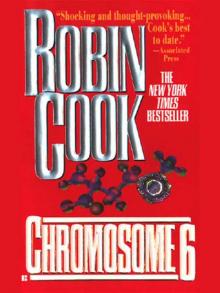 Chromosome 6
Chromosome 6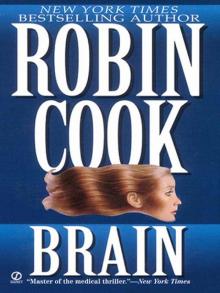 Brain
Brain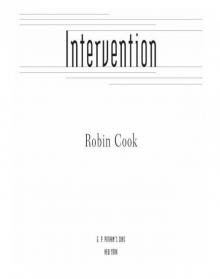 Intervention
Intervention Invasion
Invasion The Legend of Parzival: The Epic Story of His Quest for the Grail
The Legend of Parzival: The Epic Story of His Quest for the Grail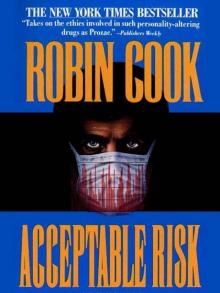 Acceptable Risk
Acceptable Risk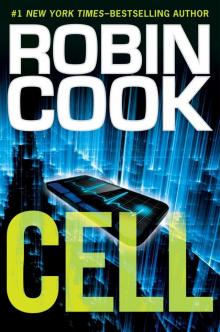 Cell
Cell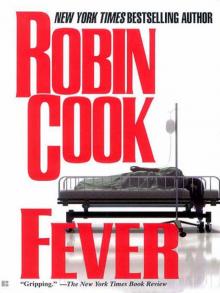 Fever
Fever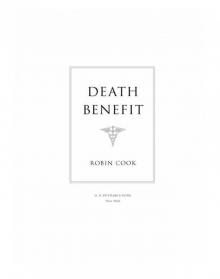 Death Benefit
Death Benefit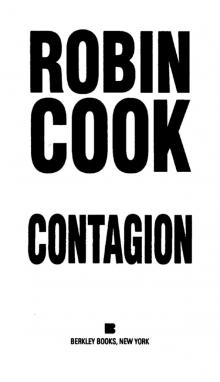 Contagion
Contagion Mindbend
Mindbend Coma
Coma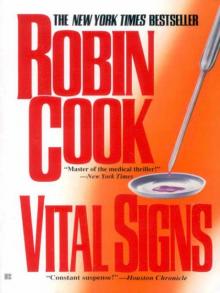 Vital Signs
Vital Signs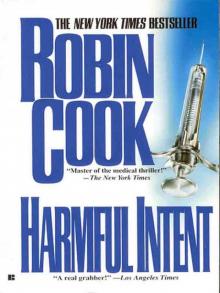 Harmful Intent
Harmful Intent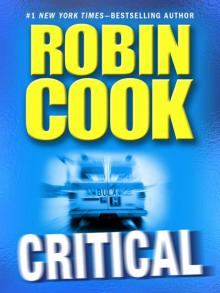 Critical
Critical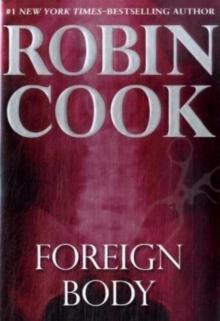 Foreign Body
Foreign Body Marker
Marker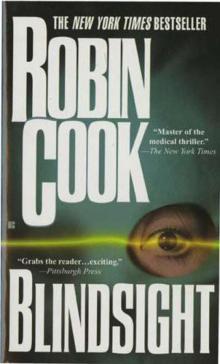 Blindsight
Blindsight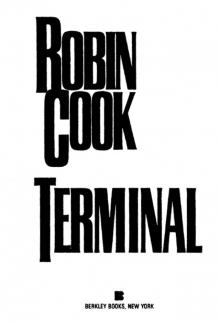 Terminal
Terminal Sphinx
Sphinx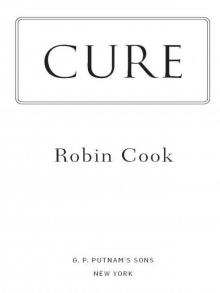 Fatal Cure
Fatal Cure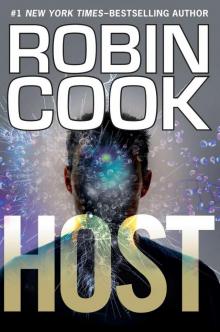 Host
Host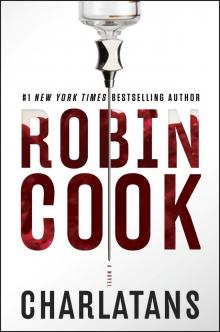 Charlatans
Charlatans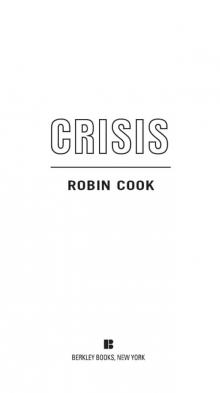 Crisis
Crisis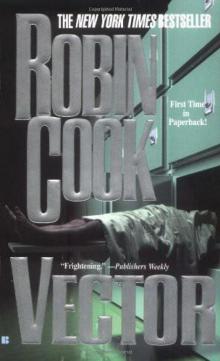 Vector
Vector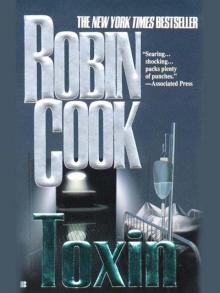 Toxin
Toxin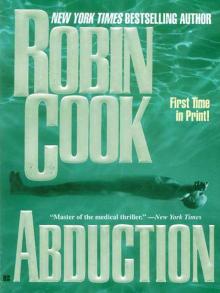 Abduction
Abduction Viral
Viral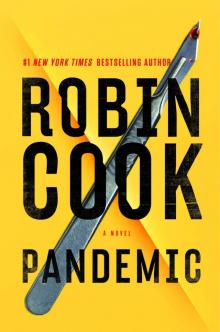 Pandemic
Pandemic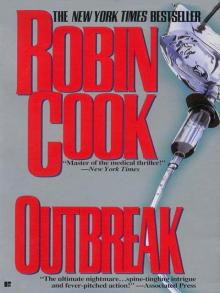 Outbreak
Outbreak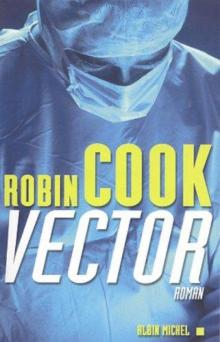 Vector js&lm-4
Vector js&lm-4 Godplayer
Godplayer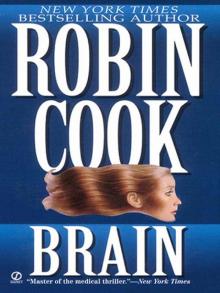 A Brain
A Brain Year of the Intern
Year of the Intern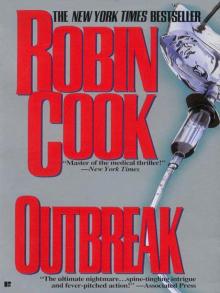 Outbreak dmb-1
Outbreak dmb-1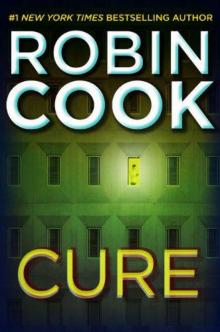 Cure
Cure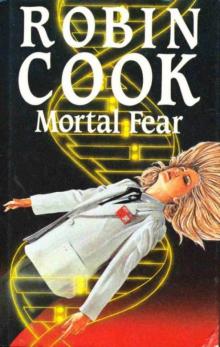 Mortal Fear
Mortal Fear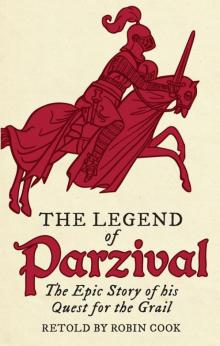 The Legend of Parzival
The Legend of Parzival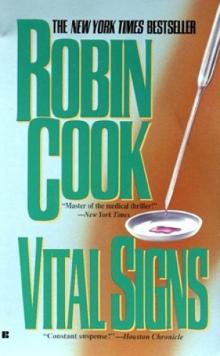 Vital Signs dmb-2
Vital Signs dmb-2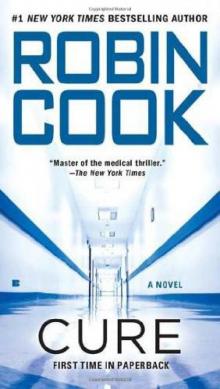 Cure (2010) sam-10
Cure (2010) sam-10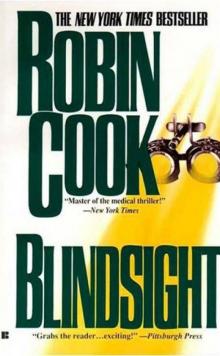 Blindsight sam-1
Blindsight sam-1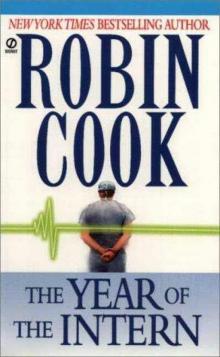 The Year of the Intern
The Year of the Intern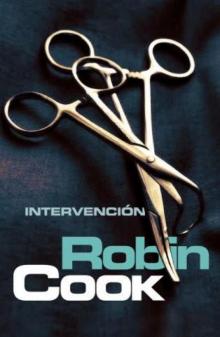 Intervention sam-9
Intervention sam-9 Foreign Body sam-8
Foreign Body sam-8